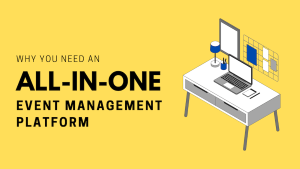Home > Blog > Event management software > The Complexities of Building an Enterprise Event Management Software
Building an enterprise event management software is a multifaceted endeavor that requires planning, a deep understanding of the event industry, and a robust tech framework. This process is not just about coding and design; it’s about creating a comprehensive tool that can adapt to the ever-evolving landscape of event management. Let’s break this down and explore the nuanced pros and cons of different development approaches.
The Process of Building an Enterprise Event Management Software
Building an enterprise event management software involves several critical steps, each demanding attention to detail and a deep understanding of the end-user’s needs. From initial planning to final deployment, this process is a blend of technical expertise, user-centric design, and continuous adaptation to emerging trends in the event industry.
1. Requirement Analysis and Planning
- Understanding Needs: This initial phase involves extensive research to understand the specific requirements of event organizers, attendees, and other stakeholders.
- Defining Scope: Detailed documentation of features, user roles, and functionalities is created.
- Resource Allocation: Deciding on the team composition, technology stack, and budget allocation.
2. Design and Prototyping
- User Experience (UX) Design: Crafting intuitive user interfaces that cater to a diverse user base.
- Prototyping: Developing a mock-up or prototype to visualize the software and gather feedback.
3. Development and Coding
- Frontend and Backend Development: Building the user interface and the server-side logic, database handling, and application integration.
- Agile Methodology: Employing iterative development processes to accommodate changes and improvements.
4. Testing and Quality Assurance
- Functional Testing: Ensuring all features work as intended.
- Performance Testing: Checking the software’s responsiveness, speed, and stability.
- Security Audits: Protecting against vulnerabilities and data breaches.
5. Deployment and Maintenance
- Launching: Releasing the software into a live environment.
- Ongoing Support: Providing continuous updates, bug fixes, and customer support.
Development Approaches: In-House or Outsourced?
Choosing the right development approach for your enterprise event management software is pivotal. Whether it’s in-house development or outsourcing, each method comes with its unique set of advantages and challenges. This section delves into these approaches, providing insights to help you make an informed decision that aligns with your organizational goals and resources.
In-House Development
Pros:
- Tailored Solutions: Develop software that precisely fits your unique workflow and branding.
- Direct Oversight: Full control over the development process, timelines, and feature prioritization.
- Data Sovereignty: Complete ownership of data, crucial for privacy and security compliance.
Cons:
- Resource Intensity: Requires significant investment in skilled developers, infrastructure, and technology.
- Time-Consuming: Longer development cycles, potentially delaying event schedules.
- Continuous Resource Allocation: Need for a dedicated team for ongoing maintenance and updates.
Outsourced Development
Pros:
- Access to Expertise: Leverage the skills and experience of specialists in event software development.
- Cost Efficiency: Potentially lower costs compared to maintaining an in-house team, especially for short-term projects.
- Faster Deployment: Leverage pre-built components and expertise for quicker market readiness.
Cons:
- Generic Solutions: Risk of receiving a less tailored product that might require additional customization.
- Dependence on Vendor: Reliance on external parties for critical updates, support, and modifications.
- Data Handling Concerns: Potential risks in data management and privacy, depending on the vendor’s policies.
When the potential drawbacks of outsourced development are effectively addressed, this approach emerges as a highly preferable option for developing an enterprise event management software. The key lies in vendor selection, clear communication, and robust contract management. By choosing a development partner with a proven track record, aligning expectations through detailed agreements, and establishing transparent, ongoing communication channels, many of the typical concerns associated with outsourcing can be significantly mitigated.
This strategic approach not only leverages the expertise and efficiency of specialized teams but also allows for a more cost-effective, scalable, and focused development process. Consequently, when managed correctly, outsourced development stands out as a smart choice, particularly for organizations aiming to combine quality, innovation, and agility in their event management solutions.
Self-Hosted vs. Fully-Managed Event Platform: Which is Better?
The decision between opting for a self-hosted event platform or a fully-managed event platform is crucial and depends on various factors including cost, control, customization, and convenience. Let’s explore the nuances of both options, offering a comparative view to assist in determining the best fit for your event management needs.
Self-Hosted Event Platform
Pros:
- Complete Customization: Ability to build a platform that aligns perfectly with specific operational needs and branding.
- Data Control: Full control over data storage, access, and security protocols.
- Integration Flexibility: Easier to integrate with existing systems and databases.
Cons:
- Substantial Initial Investment: High upfront costs in infrastructure, development, and staffing.
- Maintenance Responsibility: Requires ongoing technical expertise for updates, security, and troubleshooting.
- Scalability Challenges: Potential difficulties in scaling the platform as your event grows in size and complexity.
Fully-Managed Event Platform
Pros:
- Reduced Overhead: Eliminates the need for large upfront investments in infrastructure and development.
- Ease of Use and Maintenance: Typically user-friendly with regular updates and maintenance handled by the provider.
- Scalability and Reliability: Easily scalable to accommodate varying event sizes, with reliable uptime and support.
Cons:
- Vendor Dependence: Reliance on the provider for long-term viability, support, and data security.
- Ongoing Costs: While initial costs are lower, long-term subscription fees can accumulate.
If the inherent challenges of fully-managed event platforms are adeptly navigated, these platforms can become the optimal choice for many organizations. The key to unlocking their full potential lies in selecting a platform that offers a high degree of customization, ensuring it can be tailored to meet specific event management needs.
Additionally, establishing a strong, collaborative relationship with the platform provider can alleviate concerns about vendor dependence, as it fosters a partnership approach rather than a client-vendor dynamic. Ensuring robust data security measures and clear service level agreements further enhances trust and reliability. When these factors are addressed, fully-managed event platforms stand out for their ease of use, scalability, and cost-effectiveness, making them an attractive solution for organizations seeking a comprehensive, hassle-free event management tool.
Cost Comparison: Custom-Built Self-Managed vs. SaaS-Based Fully-Managed Event Platforms
Building a custom, fully-private event platform can be a significant financial undertaking. The costs encompass not just the initial development but also ongoing maintenance, security updates, and potential scalability needs. This option is often suited for large organizations with specific, complex requirements and the resources to support such a project over the long term.
Conversely, opting for a SaaS-based event management platform can be more cost-effective, especially for organizations seeking a balance between functionality, ease of use, and budget. With a subscription-based model, you benefit from a full suite of features, regular updates, and dedicated support, all within a predictable budget framework.
Deciding whether to build in-house, outsource, or opt for a SaaS solution is a strategic decision that hinges on your organization’s specific needs, resources, and long-term objectives. While a custom-built enterprise event management software offers unparalleled customization and control, the expertise, efficiency, and cost-effectiveness of on-demand event platforms make them an attractive choice for many. Ultimately, the right choice is the one that aligns with your event management goals and organizational capabilities.
Related Searches
- Streamlining Event Management with New Updates
- Streamline Event Management with the Latest Updates
- Why Dryfta is the Ultimate Event Management Solution
- Got a University Event? An All-in-One Platform Saves Time and Money!
- Why You Need an All-In-One Event Management Platform
- Redefine your Event with an All-in-One Event Platform
- Questions to Ask When Choosing University Event Software
- 4 Benefits of Cloud-Based Event Management Software
- Tips for Maintaining Professionalism in Event Management
- How Women Can Thrive in Event Management
- Are Event Management Apps Worth It? Benefits for Your Conference
- How Event Management Software is Reducing Human Roles






